Click on images to enlarge

habit of a large plant in flower (Photo: Sheldon Navie)

habit when growing in an open exposed position (Photo: Sheldon Navie)
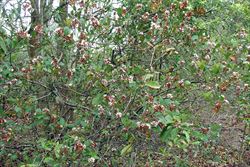
taller and sparser habit when growing in the understorey of an open forest (Photo: Sheldon Navie)

stem and alternately arranged leaves (Photo: Sheldon Navie)
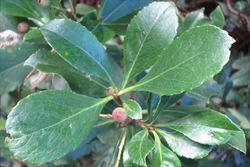
glossy leaves with toothed margins (Photo: Sheldon Navie)
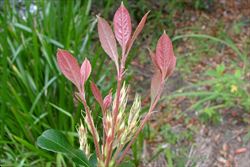
reddish-coloured new growth (Photo: Sheldon Navie)
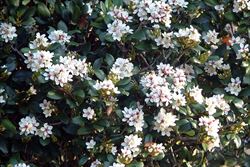
flower clusters (Photo: Sheldon Navie)
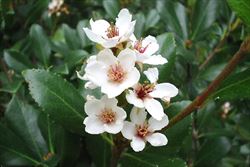
close-up of whitish flowers with numerous stamens (Photo: Sheldon Navie)
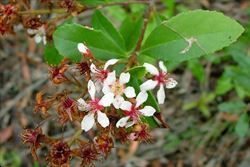
older flowers (Photo: Sheldon Navie)

immature fruit (Photo: Sheldon Navie)

bluish-black mature fruit (Photo: Sheldon Navie)

habit of pink Indian hawthorn (Rhaphiolepis x delacourii) in flower (Photo: Sheldon Navie)
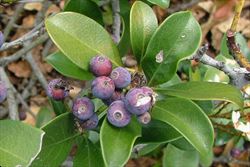
close-up of the almost entire leaves and fruit of pink Indian hawthorn, Rhaphiolepis x delacourii (Photo: Sheldon Navie)
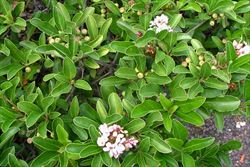
the modern cultivar 'Pink Lady' is a compact plant with pink flowers and toothed leaves (Photo: Sheldon Navie)
Scientific Name
Rhaphiolepis indica (L.) Lindl. ex Ker Gawl.
Synonyms
Crataegus indica L.
Family
Malaceae (New South Wales)Rosaceae (Queensland, the ACT, Victoria, Tasmania, South Australia and Western Australia)
Common Names
cherry laurel, common Indian hawthorn, India hawthorn, Indian hawthorn
Origin
Native to China, Taiwan and south-eastern Asia (i.e. Cambodia, Laos, Thailand and Vietnam).
Cultivation
This species is often cultivated as a garden ornamental, particularly as a hedging plant, and is particularly common in older gardens. Several modern cultivars and hybrids are also available, which are usually more compact plants with flowers ranging from white to bright pink in colour. Popular cultivars currently include 'Pink Lady' (also known as 'Ballerina'), 'Enchantress', 'Springtime' and 'Snow Maiden'. Pink Indian hawthorn (Rhaphiolepis x delacourii), a hybrid of Indian hawthorn (Rhaphiolepis indica) and Japanese hawthorn (Rhaphiolepis umbellata), is also becoming common in cultivation.
Naturalised Distribution
Naturalised in some parts of eastern Australia (i.e. in south-eastern Queensland and the coastal districts of central New South Wales). Possibly also naturalised in Victoria and in the coastal districts of northern and southern New South Wales.
Habitat
A weed of roadsides, disturbed sites, waste areas, gardens, urban bushland, open woodlands, riparian vegetation and coastal environs in the warmer temperate and sub-tropical regions of Australia.
Habit
An evergreen shrub usually growing 1-2 m tall, but occasionally a small tree reaching up to 4 m in height.
Distinguishing Features
- a shrub or small tree growing 1-4 m tall.
- its leathery leaves (3-8 cm long) have sharply toothed margins, particularly in the upper half.
- its white or pinkish flowers (10-15 mm across) are arranged in dense clusters at the tips of the branches.
- these flowers have five petals (5-9 mm long and 4-5 mm wide) and numerous stamens.
- its rounded fruit (5-10 mm across) turn from green to bluish-black or purplish-black in colour as they mature.
Stems and Leaves
The younger stems are rounded, green to purplish-brown in colour, and often covered with fine brown hairs (i.e. tomentose). Older stems are greyish-brown in colour and hairless (i.e. glabrous).
The thick and leathery leaves are alternately arranged, but usually crowded towards the ends of the branches. These leaves (3-8 cm long and 0.5-4 cm wide) are oval (i.e. elliptic), oblong or somewhat egg-shaped in outline (i.e. ovate or obovate) and are borne on short stalks (i.e. petioles) 5-18 mm long. They have sharply toothed (i.e. serrate) margins, particularly in the upper half, and rounded or pointed tips (i.e. obtuse to acuminate apices). Leaves are hairless (i.e. glabrous) or somewhat hairy (i.e. pubescent) when young.
Flowers and Fruit
The flowers (10-15 mm across) are arranged in dense clusters at the tips of the branches (i.e. in terminal paniculate cymes). Each flower is borne on a slender stalk (i.e. pedicel) 5-15 mm long and has five green or reddish sepals (4.5-6 mm long and about 2 mm wide) with pointed tips (i.e. acute apices). The five white or pinkish petals (5-9 mm long and 4-5 mm wide) may have pointed or rounded tips (i.e. acute or obtuse apices). Each flower also has numerous (about 15) stamens and an ovary topped with two or three styles that are fused together near the base. Flowering occurs mainly during spring and summer.
The rounded (i.e. globose) fruit resemble berries (i.e. they are pomes) and turn from green to bluish-black or purplish-black in colour as they mature. These fruit (5-10 mm across) are hairless and contain one or two seeds. Mature fruit are present mainly during winter (i.e. from July to August).
Reproduction and Dispersal
This species reproduces mainly by seed, which are commonly dispersed by fruit-eating (i.e. frugivorous) birds. They may also be spread in dumped garden waste.
Environmental Impact
Indian hawthorn (Rhaphiolepis indica) is regarded as an environmental weed in New South Wales and Queensland and as a potential environmental weed or "sleeper weed" in other parts of Australia. Currently, it is mainly a problem in remnant bushland in the Brisbane and Sydney regions.
This species is actively managed by community groups in New South Wales and appears on several local and regional environmental weed lists in the eastern parts of this state (e.g. in the North Coast region, in the wider Sydney and Blue Mountains region, in the Sydney North region, in Coffs Harbour City and in Byron, Warringah, Mosman, Manly and Ku-ring-gai Municipal Councils).
In Queensland Indian hawthorn (Rhaphiolepis indica) is mainly of concern in the south-eastern parts of the state, and it is listed among the top 200 most invasive plant species in this region. It also appears on some local environmental weeds lists (e.g. in Redland Shire) and is growing in conservation areas (e.g. Toohey Forest Park) in south-eastern Queensland.
While not yet formally regarded as being naturalised in Victoria and south-eastern New South Wales, Indian hawthorn (Rhaphiolepis indica) has occasionally been reported in these regions (e.g. it appears on the list of environmental weeds for Knox City in Victoria, appears on a list of naturalised plants for the Gippsland Plain bioregion, and is included in a booklet of invasive plants for the New South Wales South Coast region).
Legislation
Not declared or considered noxious by any state government authorities.
Similar Species
Indian hawthorn (Rhaphiolepis indica) may be easily confused with Japanese hawthorn (Rhaphiolepis umbellata). However, these species can be distinguished by the following differences:
- Indian hawthorn (Rhaphiolepis indica ) has broad or slightly elongated leaves with obviously toothed (i.e. serrate) margins. Its flowers are white, but sometimes pink-tinged towards the base of their petals.
- Japanese hawthorn (Rhaphiolepis umbellata ) has relatively broad leaves with margins that are almost entire or slightly toothed in their upper parts. Its flowers are usually white.
Indian hawthorn (Rhaphiolepis indica) is also relatively similar to the cotoneasters (Cotoneaster spp.), the firethorns (Pyracantha spp.) and the hawthorns (Crataegus spp.). However, these species all have orange or reddish coloured mature fruit. The firethorns (Pyracantha spp.) and the hawthorns (Crataegus spp.) also have thorns on their stems, while the cotoneasters (Cotoneaster spp.) have entire leaves.

